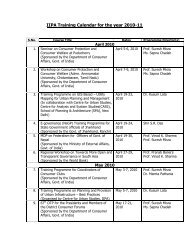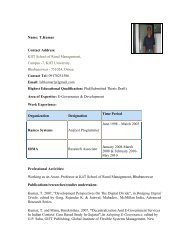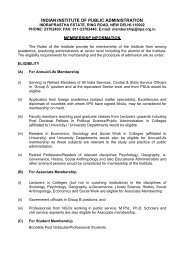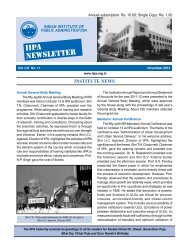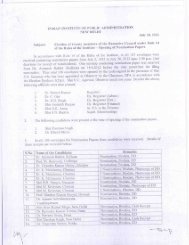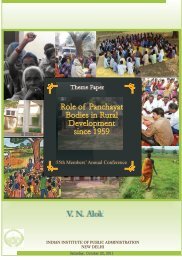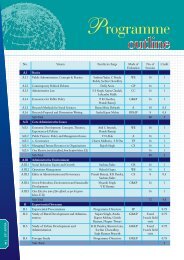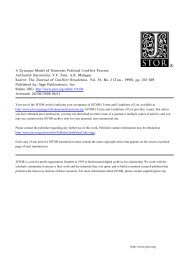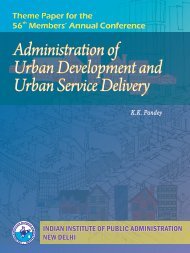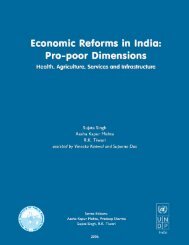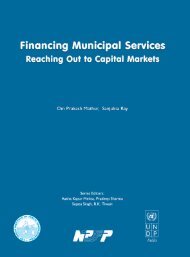India's Telecom Reform - Indian Institute of Public Administration
India's Telecom Reform - Indian Institute of Public Administration
India's Telecom Reform - Indian Institute of Public Administration
Create successful ePaper yourself
Turn your PDF publications into a flip-book with our unique Google optimized e-Paper software.
India’s <strong>Telecom</strong> <strong>Reform</strong>: A Chronological Account<br />
1995: Working fixed lines cross 10 million, annual fixed<br />
line growth crosses 20 percent.<br />
1995, January 16: Tenders invited for cellular services in<br />
the rest <strong>of</strong> India.<br />
1995, March: Paging services debut in India.<br />
1995, March 15: The Gupta Committee makes recommendations<br />
regarding the restructuring <strong>of</strong> DoT.<br />
1995, May 27: DoT issues clarifications and announces<br />
several changes in the original tender conditions <strong>of</strong> the basic<br />
services. Tender opening date extended to June 23, 1995.<br />
1995, June 07: DoT receives 33 bids for mobile services<br />
in 18 telecom circles. No bidders for Andaman & Nicobar<br />
and Jammu and Kashmir circles.<br />
1995, June 23: 81 bids received for fixed line (basic) services<br />
in 20 Circles. No bids for Jammu and Kashmir.<br />
1995. August 05: DoT opens financial bids for cellular<br />
mobile services.<br />
1995, August 15: VSNL begins public Internet access in<br />
selected cities.<br />
1995, August 23: Modi Telstra launches the first cellular<br />
operation in the country in Calcutta.<br />
1995, November 2: The government announces that no<br />
company may retain more than three A and B Circle<br />
licences.<br />
1995, December 1: Second round <strong>of</strong> bidding for basic<br />
services in 13 Circles.<br />
1995, December 12: DoT issues 34 licenses to 14 companies<br />
for operating cellular services in the 18 telecom Circles.<br />
1996, January 1: Bids for basic services opened. Only six<br />
companies participate in the bidding. Only five Circles out<br />
<strong>of</strong> 13 receive acceptable bids.<br />
1996, March 12: Letter <strong>of</strong> Intent awarded to highest bidders<br />
in the second round <strong>of</strong> bidding.<br />
1996, March 15: Third round <strong>of</strong> bidding for basic service<br />
licenses for nine Circles.<br />
1996, May: Draft Interconnect Agreement released by<br />
DoT. Discussions begin with mobile operators.<br />
1996, July 23: TRAI Bill introduced in Lok Sabha.<br />
1996, October: Mobile licenses issued to two operators<br />
each in 20 Circles.<br />
1996, November: DoT allows assignability <strong>of</strong> cellular licenses,<br />
meeting the demand <strong>of</strong> financial institutions.<br />
1997, February: India signs <strong>Telecom</strong>munications Basic<br />
Services agreement at World Trade Organisation (WTO)<br />
allowing companies with up to 25 percent foreign equity<br />
access to most parts <strong>of</strong> its telecom market. It signs up for<br />
a regulatory reference paper that forms part <strong>of</strong> the agreement,<br />
but its commitment does not include important competitive<br />
safeguards relating to state owned and other incumbents,<br />
independent regulators and issues such as interconnection<br />
and spectrum fees.<br />
1997, March 18: TRAI Bill, 1997, a modification <strong>of</strong> the<br />
previous Bill presented a year ago, passed by the Lok Sabha<br />
and the Rajya Sabha.<br />
1997, March 25: TRAI is set up with three members.<br />
1997, March 26: COAI approaches TRAI against DoT’s<br />
order that hikes the price <strong>of</strong> fixed to mobile calls.<br />
1997, April: Mobile services commence in non-metro<br />
Circles.<br />
1997, April 25: TRAI quashes DoT’s PSTN to mobile<br />
tariff order.<br />
1997, September 12: DoT gives clearance for national<br />
automatic roaming.<br />
1997, October 10: MTNL indicates intention to enter into<br />
cellular services in its GDR Prospectus.<br />
1997, November 3: Cellular operators seek TRAI intervention<br />
to stop MTNL’s plans to <strong>of</strong>fer mobile services.<br />
1997, November 19: Private operators permitted to make<br />
their licenses assignable in favour <strong>of</strong> the lenders.<br />
1997, December 4: Consultation paper on numbering plan.<br />
20




